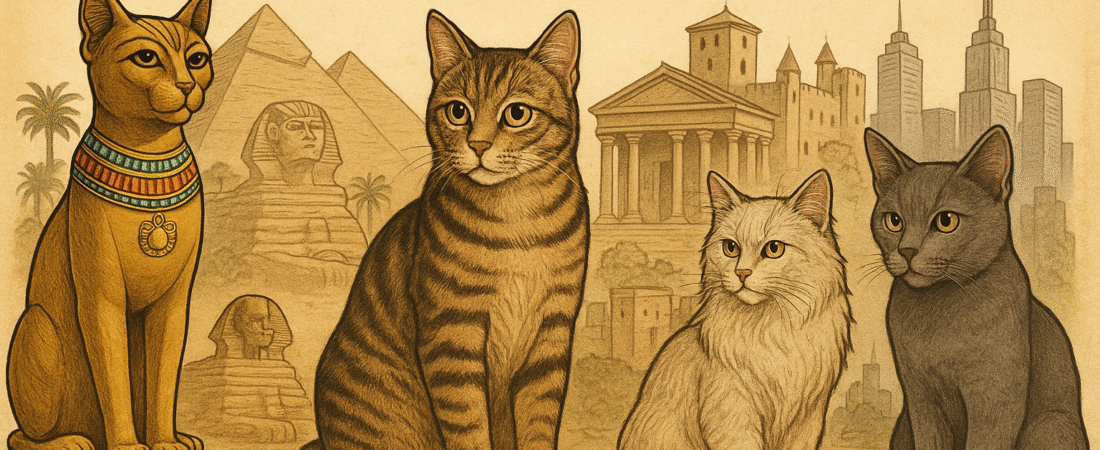Cats have been companions to humans for thousands of years, with their history deeply intertwined with ancient civilizations. The domestication of cats likely began around 10,000 years ago in the Near East, eventually leading to their revered status in ancient Egypt, where they were honored and protected by law. From there, cats spread across various cultures, each assigning their own unique significance to these animals.
Throughout history, cats have played diverse roles—from pest controllers on ships to symbols of mystery and independence. Their perception has shifted over time, influenced by cultural beliefs and social changes, shaping how cats are viewed and valued in society today. Understanding this journey shows how cats evolved from wild hunters to beloved household companions.

Key Takeaways
- Cats were first domesticated in the Near East and highly honored in ancient Egypt.
- Different cultures have assigned cats varying symbolic meanings and practical roles.
- The modern relationship with cats reflects centuries of cultural transformation and appreciation.
Ancient Egypt: The Origins of Cats in Human Society

Cats first became integral to human life in ancient Egypt, where their domestication involved religious practices as well as practical benefits. Their presence influenced culture, religion, and everyday activities, establishing a foundation for their evolving role worldwide.
Domestication and Early Human-Cat Relationships
Cats descended mainly from the African wildcat (Felis lybica lybica), whose domestication in Egypt dates back about 3,000 years. Unlike earlier theories that tied domestication to farming communities, recent research suggests that ritualistic practices accelerated their taming. Egyptians kept wildcats close in sanctuaries dedicated to the goddess Bastet, fostering a relationship based on both spiritual reverence and pest control.
Cats were valued for protecting granaries by hunting rodents and snakes. This utilitarian role likely encouraged humans to adopt more docile cats, merging survival needs with cultural habits. The interaction between agrarian society and feline behavior created a unique bond that continued to grow over centuries.
Religious and Cultural Significance
Cats held a sacred position linked to the goddess Bastet, initially depicted with a lion’s head and later as a cat. Bastet symbolized protection, fertility, and good health. Temples dedicated to her housed millions of mummified cats as offerings, reflecting their divine status within society.
This religious veneration led to laws protecting cats and strict trade restrictions to prevent their export. They became more than hunters; they embodied spiritual guardianship and moral authority. This sanctity inspired breeding and large-scale rituals involving cats, blending worship with everyday interaction.
Cats in Art, Mythology, and Daily Life
Cats appeared frequently in Egyptian art, from sculptures and paintings to jewelry. Their graceful image symbolized balance and poise. Mythologically, cats were seen as protectors against evil spirits and enforcers of order, reflecting their real threat to pernicious pests.
In daily life, cats lived inside homes, cherished both as pets and protectors. Their image decorated tombs and household objects, illustrating the deep connection Egyptians felt toward them. This rich artistic and cultural presence set a precedent for cats as companions and symbols in civilizations that followed.
Learn more about the deep roots of cat domestication and cultural impact in ancient Egypt at How Cats Became Divine Symbols in Ancient Egypt.
Cats Across Civilizations: Expanding Influence

Cats shaped human societies in many ways beyond their early roles. Their interaction with different cultures influenced religion, daily life, and social attitudes. They shifted from practical pest controllers to symbols of mystique and reverence.
Cats in Greece and Rome
In Ancient Greece, cats were valued mainly for their pest-control abilities, protecting food stores from rodents. However, they did not receive the same level of religious or symbolic significance as in Egypt.
The Romans elevated cats’ status by incorporating them into households as pets and symbols of liberty. Laws acknowledged cats as property, and their likeness appeared in art and mosaics. Notably, Roman writers praised cats for their agility and hunting skills, helping to control rats and snakes.
Cats also played roles in trade, traveling with merchants and soldiers across the empire, which helped spread their presence throughout Europe and parts of Asia, fostering their integration into diverse cultures.
Asian Perspectives on Cats
Cats hold varied importance across Asian cultures. In Japan, the maneki-neko, or “beckoning cat,” symbolizes good fortune and prosperity. This figure, often portrayed with a raised paw, is common in homes and businesses.
In China, cats were admired especially for their ability to catch vermin that threatened valuable silk production. Over centuries, they became associated with luck and protection.
Cats appear in folklore and religious contexts throughout Asia, sometimes linked with spiritual guardianship or supernatural abilities. Their evolving symbolic roles contrast with purely utilitarian views seen elsewhere.
Cultural Spread in Medieval Europe
During the Middle Ages, cats in Europe faced fluctuating reputations. Initially, their rodent control made them valuable, but by the late medieval period, cats became associated with witchcraft and superstition.
This shift led to widespread persecution, especially of black cats, which were considered familiars of witches. Despite this, cats continued to thrive in rural and urban settings, controlling pests in granaries and households.
The negative perception began to wane toward the Renaissance, as cats regained favor as companions and practical assets. Their survival through these periods demonstrates their enduring utility and adaptability.
For more detailed information about cats’ roles across eras, see Cats Across Cultures: Exploring Their Enduring Influence in History.
Transformation Through the Ages: From Middle Ages to Modern Era

Cats experienced a turbulent shift in their cultural status between the Middle Ages and modern times. Their roles moved from feared creatures linked to superstition to admired companions and defined breeds. This transformation reflects broader changes in social attitudes and practices regarding animals.
Superstitions and Persecution in the Middle Ages
During the Middle Ages, cats, especially black ones, were frequently associated with witchcraft and evil spirits. This led to widespread persecution, including mass killings driven by fear and superstition. Cats were often believed to be familiars of witches or embodiments of the devil.
Despite this, cats remained valued for their natural pest control abilities. In agricultural and urban settings, their role in limiting rodent populations helped protect food stores and health. This practical benefit slowly shifted public opinion, though negative beliefs persisted for centuries.
The Renaissance and Changing Attitudes
The Renaissance sparked a cultural renewal that affected many domains, including attitudes toward cats. Artists and intellectuals began portraying cats more sympathetically, highlighting their grace and mystery through paintings and literature.
Cats were increasingly seen as symbols of independence and elegance rather than omens of evil. This period helped reestablish their place in households, encouraging companionship beyond mere utility. The Renaissance laid foundations for the modern emotional bond humans share with cats.
Emergence of Cat Breeds and Pet Keeping
By the late 17th and 18th centuries, the practice of selectively breeding cats emerged, producing distinct breeds with recognizable traits. This era marked the beginning of cats as pets beyond their functional roles.
Organizations and exhibitions later in the 19th century formalized breed standards. The Victorian era saw the rise of cat shows and a surge in pet keeping as a social norm. Cats became fashionable family companions, symbolizing domestic comfort and refinement rather than superstition or utilitarian roles.
This evolution of cats through history highlights their adaptability and changing human perceptions over time. For more details on these shifts, refer to the history explored at The History of Cats as Companions Through Different Cultures.
Cats in Contemporary Times: Popularity and Cultural Impact

Cats remain among the most popular pets worldwide, valued for their adaptability and distinct personalities. Their influence extends beyond companionship to media, culture, and scientific fields. Understanding their modern roles highlights how cats continue to shape human life.
Cats as Modern Companions
Cats are widely appreciated for their balance of independence and affection, making them suitable for diverse living environments. Urban dwellers often prefer cats due to their small space needs and low maintenance compared to larger pets.
Their role as companions includes emotional support; many owners report reduced stress and loneliness when living with cats. Care standards emphasize proper nutrition, veterinary care, and environmental enrichment like scratching posts and playtime.
Popular in households across continents, cats contribute to millions of daily interactions, adapting well to indoor lifestyles while still expressing natural behaviors. This combination solidifies their status as beloved pets.
Cats in Media and Popular Culture
Cats frequently appear in books, movies, and internet content, shaping public perceptions. Iconic fictional cats and viral videos have elevated their status to global recognition and cultural symbols of mystery or independence.
Memes and social media platforms widely promote cats, often highlighting their quirky behaviors or playful personalities. This visibility supports pet adoption campaigns and raises awareness of animal welfare.
Historical reverence, like that in ancient Egypt, continues to inspire artistic representation. Cats symbolize comfort and companionship, balancing ancient symbolism with modern interpretations at the heart of popular culture.
Scientific Research and the Role of Cats Today
Cats are subjects in numerous scientific studies, especially regarding behavior, genetics, and human-animal interactions. Research on their communication methods, such as vocalizations and body language, improves understanding of feline needs and welfare.
Genetic studies trace the evolution and domestication of cats, linking modern breeds to ancestors from the Near East approximately 10,000 years ago. These insights support better breeding practices and health management.
Additionally, cats play roles in therapy, assisting in mental health treatments and reducing anxiety in patients. This further illustrates their multifaceted contributions beyond being mere pets. More information can be found on the fascinating history of cats.
Frequently Asked Questions
Cats descended from wild ancestors native to the Near East, where domestication began around 10,000 years ago. Their roles and significance have evolved through various cultures, particularly in ancient Egypt. Cats’ journey includes major historical milestones and deep mythological symbolism across societies.
How did domestic cats originate from wild ancestors?
Domestic cats evolved from the African wildcat species, Felis silvestris lybica. Early humans living in agricultural societies in the Near East welcomed cats for their rodent control, leading to gradual domestication.
What roles did cats play in ancient Egyptian society?
In ancient Egypt, cats were sacred animals linked to the goddess Bastet, symbolizing protection and fertility. Egyptians revered, mummified, and sometimes worshipped cats, integrating them into both religious and daily life.
What are some significant milestones in the historical timeline of cats?
Key milestones include initial domestication in the Near East, cats spreading to ancient Egypt, their role on ships during European exploration to control pests, and changing perceptions from superstition in the Middle Ages to popular pets in the Renaissance.
Can you detail the mythological significance of cats throughout history?
Cats featured in Greek and Roman mythology as mystical creatures and protective symbols. Celtic myths viewed them as shapeshifters guarding otherworldly realms. In the Middle Ages, superstition linked cats to witchcraft, reflecting contrasting cultural views.
Which cultures or civilizations first regarded cats as domestic pets?
The first likely domestic cats appeared in the Near East, around modern Turkey. Ancient Egyptians were among the earliest civilizations to elevate cats beyond pest control to revered companions and spiritual symbols.
When and by whom were cats introduced to the Americas?
Cats were introduced to the Americas by European explorers and settlers during the Age of Exploration starting in the 15th and 16th centuries. They helped protect food supplies from rodents on ships and later in colonies.
For more details, refer to the Fascinating History of Cats and related articles.
More related articles:
- Why Cats Love Boxes (and How to Use This to Enrich Their Lives)
- Do Cats Dream? The Sleep Habits of Felines
- 15 Funniest Cat Behaviors Explained

